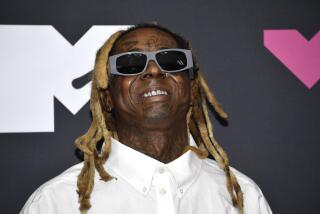Wayne Evokes Opposing Views of Past
- Share via
John Wayne has been dead for 17 years, so why have some Los Angeles County firefighters and their bosses been fighting a racially charged battle over whether his picture should hang in fire stations?
What is it about Wayne that appears to make him a symbol of America’s best to many whites and a symbol of oppression to many blacks? Why is a man whose work and public comments rarely dealt overtly with race still a lightning rod for racial anxieties?
The answer, experts in film and culture say, is that blacks--like whites--see Wayne’s on- and off-screen persona as a powerful symbol of the past. For many blacks and minorities, they are not the good old days.
Todd Boyd, professor of critical studies at USC School of Cinema and Television, said that in the 1960s and early ‘70s, the peak years of black political activity, Wayne began to represent an “outdated version of American white superiority and dominance that African Americans were beginning to question. John Wayne embodied that image.”
*
Wayne has long been--and remains--one of the nation’s most popular film stars. He ranked first in a 1995 Harris poll that included Clint Eastwood, Mel Gibson and Denzel Washington. He slipped to second this year behind Gibson.
All of which explains why Wayne’s image is still used in a beer commercial to exemplify the ideal American fighting man--and why a popular rap song vilified him. It also explains why two times in the last three months, Wayne’s legacy has created controversy in fire stations from Carson to Palmdale.
Dozens of Wayne posters or cutouts have been appearing in county firehouses since September, when a black battalion chief removed a Wayne photo that had hung for 20 years in the Carson station. Two weeks ago, a white firefighter in Palmdale filed a union grievance against another black battalion chief, alleging that he was harassed by the chief after he put up a 6-foot cardboard cutout of Wayne in the station’s recreation room.
Observers said those controversies were due in part to labor-management tensions, but the racial undercurrents were impossible to miss.
“He was an avowed racist and seldom had anything to do with blacks,” said Maggie Hathaway, the former president and founder of the Beverly Hills-Hollywood branch of the NAACP.
As chapter president, Hathaway said, she once led a picket line in 1979 around a Crenshaw-area Great Western Bank branch to force it to remove pictures of Wayne.
“There is a vast difference between the John Wayne of ‘The Searchers’ who was playing a role and the John Wayne who was being utilized by certain white males in the Fire Department to antagonize black males,” said Los Angeles filmmaker Roy Campanella II, who produced a PBS documentary on blacks in film. “They are sending a message that some whites see as subtle, and black see as an obvious challenge.”
Wayne became famous portraying the frontier virtues of honesty, rugged individualism and a willingness to fight for what he believed in. When he died in 1979, Congress struck a gold medal that simply read: “John Wayne, American.”
But he was also the anti-Communist, the Vietnam War hawk, the member of the John Birch Society. He was the leading man in films that often stereotyped Native Americans and Asians.
Some of Wayne’s critics recall a 1971 Playboy interview in which Wayne, responding to a question about activist Angela Davis, said:
“With a lot of blacks, there’s quite a bit of resentment along with their dissent, and possibly rightfully so. But we can’t all of a sudden get down on our knees and turn everything over to the leadership of the blacks. I believe in white supremacy until the blacks are educated to a point of responsibility. I don’t believe in giving authority and positions of leadership and judgment to irresponsible people.”
*
The words did much to poison the star’s mystique among many blacks. To some it was reminiscent of a remark that a young Elvis Presley, who borrowed heavily from black music, was rumored to have made: “The only thing a colored person can do for me is shine my shoes and buy my records.” Both men were linked together as racists by rapper Chuck D in Public Enemy’s powerful rap anthem “Fight the Power.”
“Wayne offers a sense of nostalgia,” said Leo Braudy, professor of English at USC. “To the extent that white males feel embattled, they may want a white icon to rally around. It’s like a saint’s image.”
Braudy, who wrote “The Frenzy of Renown: Fame and Its History,” says it is telling that in Wayne’s Hollywood world there is no affirmative action, women knew their place, Native Americans were savages and Japan was a backward country with no regard for human life.
Whites who are uncomfortable with some subsequent changes in society “call on Wayne as the father who would never have let this happen,” Braudy said. “It is rallying, invoking icons as patron saints.” They contrast “the Duke,” his loping stride, tilted stance and signature gruff voice, to the uncertain values of today, he said.
Wayne, a native of Iowa who was born Marion Morrison, moved to California as a child and attended Glendale High School, where he excelled academically and athletically. While on scholarship at USC, he worked summers in the film studios. He first appeared on film as a walk-on at the end of John Ford’s “Hangman’s House” in 1928. He played in a series of B movies until 1939, when Ford cast him as the Ringo Kid in “Stagecoach,” launching him on the road to stardom. During World War II, he played the hero in such films as “Back to Bataan,” “Sands of Iwo Jima,” and “Flying Leathernecks.”
*
In all, there were more than 200 films, including “True Grit” in 1969, for which he won the Oscar for his portrayal of cantankerous marshal Rooster Cogburn.
Near the end of his life, Wayne took issue with his image as an extreme rightist Republican.
“In my own mind I’m liberal to the point where I will listen to every point of view, which takes me out of the extremist class on both sides,” he said in a 1976 interview. “And I have as much love for my fellow man, and I enjoy them as much as anyone. “
He poked fun at his own macho image in 1974 when he appeared in Cambridge, Mass., in an armored personnel carrier at the invitation of the Harvard Lampoon.
About the same time, he gave an interview to the Advocate, a California-based gay newspaper, which quoted him as saying, “A man has the right to live his life as he wishes.”
Shortly after Wayne’s death, at age 72, President Jimmy Carter issued a statement describing Wayne as a hero. “He was a symbol of many of the most basic qualities that made America great,” Carter wrote. “The ruggedness, the tough independence, the sense of personal conviction and courage--on and off the screen--reflected the best of our national character.”
That--not a symbol of racial antagonism--is the Wayne that Ken Wlaschin, director of creative affairs with the American Film Institute, remembers.
“Yes, he represented a different time, a time of individual stuff,” Wlaschin said. “I don’t think he would like to be seen as a symbol of anything. He liked to stand for himself.”
More to Read
Only good movies
Get the Indie Focus newsletter, Mark Olsen's weekly guide to the world of cinema.
You may occasionally receive promotional content from the Los Angeles Times.










